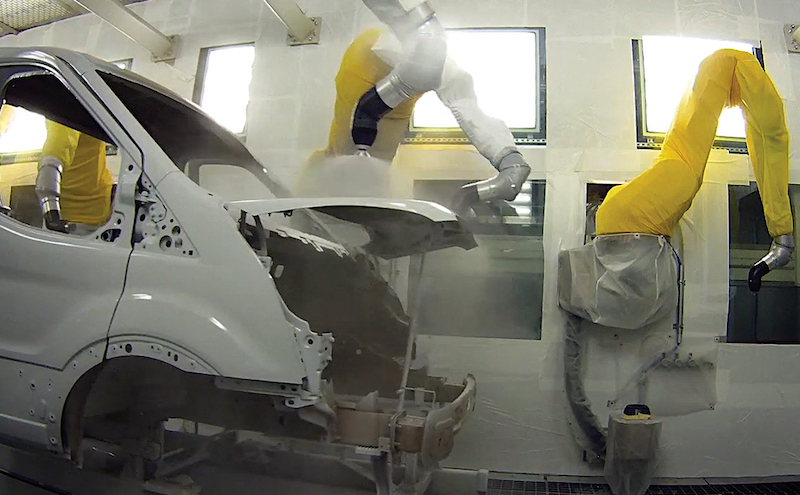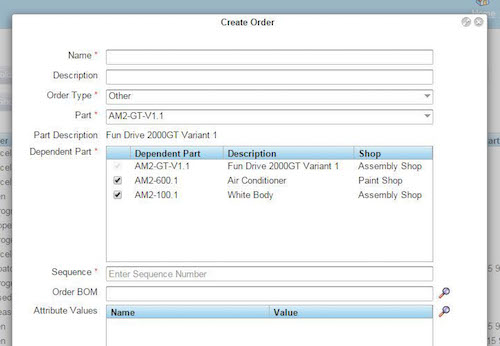As OEMs look to reduce energy consumption in their paintshops, the latest software can improve efficiency
Paintshops account for the greatest energy use at any automotive manufacturing operation – around 70%, says Bill Sarver, senior consultant, Global Automotive at Rockwell Automation – and that makes efficiency in this area crucial to the success of an OEM’s sustainability policy. Energy management also plays a significant role in increasing plant productivity, which leads to improved competitiveness. Engelbert Lang, head of energy management at Siemens’ Digital Factory Division, Factory Automation, says the key considerations for vehicle-makers centre on rising energy costs, stringent regulations and sustainability requirements, the drive to meet corporate targets for productivity and efficiency, and the desire to continuously discover potential savings.
According to Sarver, challenges arise because paintshop energy efficiency falls into different operational areas, including: the paint process itself; the materials used; the formulation and application of the paint; the paint facilities and the management of them; and the cost and ROI of energy-saving initiatives. “The number-one area that automotive manufacturers are looking at is what they can do to change the process,” says Sarver. “Companies are moving away from running multiple ovens and curing individual layers of paint before applying the next layer. Most automakers are migrating to Ford’s model, where you apply multiple levels of paint before they are then cured.” By changing the formulation of the paint and enhancing its properties, one layer can be applied on top of an existing wet layer, then cured without any peeling. The use of fewer ovens reduces the amount of power needed to cure the paint.
“The number-one area that automotive manufacturers are looking at [to improve paintshop efficiency] is what they can do to change the process… Most automakers are migrating to Ford’s model, where you apply multiple levels of paint before they are cured” – Bill Sarver, Rockwell Automation

Improving the visibility of energy consumption is a crucial aspect of understanding its use, identifying waste and taking action to increase efficiency. Lang says that, by installing appropriate IT systems, vehicle-makers can achieve better transparency of energy consumption and generate more reliable reports as the basis for decision-making. They can also run benchmarks to identify inefficient equipment. “Automotive manufacturers can identify standby consumption and abnormalities in consumption patterns and analysis of inefficient production methods,” he says. The Siemens energy management solution, SIMATIC, helps with this by providing visibility on the flow of energy in production facilities, thus enabling the analysis and identification of potential energy savings.
“SIMATIC Energy Suite efficiently links energy management with automation, which makes energy usage in production more transparent,” says Lang. “The simplified planning of energy-monitoring components also significantly reduces configuration outlay. The result is increased efficiency over the long term, higher productivity and an improved cost situation.”
Since this solution offers end-to-end connection with SIMATIC Energy Manager PRO, as well as Siemens’ Cloud-based Service Energy Analytics software, OEMs can expand their energy data to form a multi-site energy management system, creating the basis for a sustainable business as per ISO 50001 regulations. This method covers reporting, purchasing, monitoring and planning with regard to energy management.
Controlling energy consumptionOne focus for Rockwell is control systems for paintshops. The company has worked with automotive manufacturers on the development of a new, modular paint rectifier which not only reduces paint use but also helps to cut energy consumption. “It works by creating a profile for each vehicle, so instead of having a static algorithm with the same amount of paint applied across each vehicle, it allows for the adjustment of paint application for each individual vehicle,” says Sarver. “When no vehicles are being painted, the system can turn the rectifiers off so they are not consuming any energy. You can then take that concept and apply it through the whole process. This works by detecting the location of a vehicle and turning power systems off, or putting them in a controlled state where they consume less energy, when the system says they aren’t going to be used given the vehicle’s location.”
 Software provided by companies such as Rockwell can offer vehicle-makers greater control over the conditions inside their paintshops
Software provided by companies such as Rockwell can offer vehicle-makers greater control over the conditions inside their paintshopsRockwell’s Model Predictive Control software, traditionally used in the food and drinks industries to monitor the environment and predict how a machine or app will function based on changing conditions, is now being used in the automotive industry. “We’ve applied this in the paintshop to enable better control in terms of manipulating air flow, temperature and humidity,” says Sarver.
“This provides better control of the paint application and drying process as well as the air balancing in the paintshop, with the ability to decrease the speed or turn off the motors to reduce energy usage. By tightening up control of these processes, the paintshop uses less energy.”
This is all brought together by Rockwell’s VantagePoint manufacturing execution system, which integrates the processes and systems with maintenance and predictive information. Connecting these disparate systems enables the aggregation and analysis of data to carry out improved modelling and diagnosis. Rockwell has been working with the industrial technology standards organisation, the Open DeviceNet Vendor Association (of which it is a founding member), on developing technology to make every connected device self-aware so that it shuts down or goes into standby when not in use.
Siemens also operates in the control-system environment via its PROFIenergy solution, which allows individual loads or complete sections of the paintshop to be shut down on a coordinated, centrally controlled basis during break times. The system compensates for load peaks by deactivating loads which are not currently needed, or switching them to sleep mode. “The coordinated deactivation of power loads that are not required during protracted periods of production standstill, such as company holidays, can help save up to 80% of energy usage,” explains Lang. “Over shorter breaks, such as lunchtimes, auto manufacturers can save up to 40%.” He says that PROFIenergy can be integrated into existing machines and production lines using PROFInet, which allows drives and their individual components such as control units or background lighting to shut down in a coordinated sequence.
Planning for smooth implementationVehicle-makers are not only building new paintshops from scratch, with energy efficiency at the forefront of the planning process, but retrofitting existing facilities to reduce energy use. The challenge with brownfield sites is that any new IT system has to be implemented with minimal disruption to operations. “Auto manufacturers have to think about how long it takes to install and how long the downtime may be, as well as any risk to production and how long it will take to set up the system and validate it before it goes live,” says Sarver. “Another consideration is whether upgrades could or should be done all at once or in phases.”
According to Lang, retrofits are a key factor in long-term, energy-saving strategies in paintshops and are also a valuable investment on their own. “With Siemens’ retrofit for Integrated Drive Systems, automotive companies can extend the lifetime of the machines used in paintshops,” he says. “Thanks to the potential energy savings, your investment in a retrofit usually pays off in just a few months, and quickly lowers operating costs over the long term by making additional potentials available.” Siemens offers retrofit options for its own products as well as other brands, ranging from duplications, upgrades and the replacement of individual components to the implementation of complex retrofit projects.
“The coordinated deactivation of power loads that are not required during protracted periods of production standstill, such as holidays, can help save up to 80% of energy usage. Over shorter breaks, such as lunchtimes, auto manufacturers can save up to 40%” – Engelbert Lang, Siemens
Siemens’ IT solutions for improving energy efficiency include its Energy Analytics offering, consisting of energy data management as a managed service. Through this software, Siemens collects, manages and maintains an automotive manufacturer’s energy and related production data. This means that the OEM no longer has to invest time and resources in analysing the data from energy use in a paintshop.
“With [the] Energy Analytics service, Siemens helps automotive manufacturers to achieve the necessary transparency by providing smart reports and dashboard with KPIs [key performance indicators] showing where in the manufacturing process exactly the energy is consumed, a key consideration considering that paintshops use a lot of energy,” explains Lang. The service also supplies recommendations for energy efficiency measures which could be implemented. “The Siemens Operation Center delivers insights into the plant’s energy and process performance, to reduce operational costs and find answers to compliance with regulation and requirements,” he says.
Given the huge consumption of energy in vehicle paintshops, and the associated potential for massive savings, the automotive industry will no doubt continue to be a big focus for software developers. As a result, the coming years are likely to see the introduction of increasingly sophisticated IT solutions to anticipate, identify and address energy management needs – bringing benefits for OEMs in terms of efficiency, productivity and sustainability.
In February 2016, Rockwell Automation announced an agreement to purchase MagneMotion, a Massachusetts-based manufacturer of intelligent conveying systems which are used for a variety of industrial applications, including automotive, general assembly, packaging and material handling. “Our recent acquisition of Jacobs Automation [of Kentucky] and its [motion control] iTRAK technology is complementary to MagneMotion’s portfolio,” said Marco Wishart, vice-president and general manager of Rockwell’s motion-control business, at the time of the announcement. “We see a future where the transportation of products within the factory, whether inside of a particular machine or between machines, will be fully controlled to optimise the productivity and flexibility of the entire process.”
According to Bill Sarver, senior consultant, Global Automotive, at Rockwell Automation, there is “potential to not only use MagneMotion technology in the bodyshop, but also in the paintshop”. He adds: “Potentially, automakers could replace the roller-bed conveyors, which would enable better control and improved speed of vehicle transfer, while automatically turning the roller-bed conveyors off in areas where they are not being used.”
Once the acquisition is finalised, MagneMotion will be integrated into Rockwell’s motion-control business, within the Architecture and Software segment. Rockwell is headquartered in Wisconsin and active in over 80 countries.





































